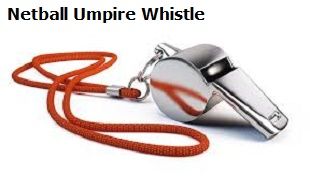Hand Signals and Whistle Use in Netball
One of the key roles of officials is using precise and sequenced terminology to indicate, and then state, any rule infringements.
Thus, umpires need to give clear voice calls combined with sharp whistle prompts. They also use gestures (hand signals) for further clarity.
Doing so means all competitors receive appropriate and unambiguous enforcement of the regulations handed out by ruling officials.
Players face many challenges during a match. Hence, umpires should make clear decisions using the correct and comprehensive phrasing.
There is some help for trainee referees and inexperienced umpires in the IFNA Rule Book. But, netball umpiring tips tend to be limited and minimal.
Here’s the bottom line:
Try to keep things simple and use the right umpiring terminology. Simply put, it should reflect which rule is being penalized on the court and with clarity.
The officials sometimes refer to the proper sequencing as the 5 ‘W‘s. They play a similar role to those covered in our netball frequently asked questions, and apply to most infractions in the game.
This list will help you learn what to say (and what not to say) as an umpire. The explanations should follow that precise moment when you blow the netball whistle for an infringement or rules’ violation.
5 ‘W’ Terms of Netball Umpiring
- What: What is the infringement?
- Who: Who committed the rules violation?
- What: What advantage has been awarded?
- Who: Who is receiving the advantage?
- Where: Where should the next play get taken from?

Note: A loud whistle and good strong voice are an umpire’s two chief tools. Whistleblowing stops the play and speech controls the game. Give clear instructions with brief reasoning behind your decision to both teams. The communication should also extend to any other umpires and assistants.
Umpiring Terms and their Meanings
The expressions in bold font represent common umpiring terminologies and rulings. The phrases (explained in brackets) are brief descriptions of the correct netballing terminologies that they relate to:
- Contact:(hand to ball) (ball to hand) (contact from behind)
- Obstruction: (falling in) (arms before distance) (too close or distance)
- Out of Court: (make it clear who last touched the ball when two players are both going for the same ball)
- Throwing in Offside Area: (throwing in from behind an offside area)
- Throw on to Red/Blue: (out of court reds/blues)
- Replayed Ball or Playing the Ball: (double bounce)
- Incorrect Setting or Penalty Not Set: (reverse the penalty)
- Delaying Play: (time wasting)
- Footwork: (stepping, hopping, dragging)
- Simultaneous Offside: (both offside)
Netball Whistle and Communication
Umpires and referees use a finger whistle to state their decisions and emphasize playing regulations. As a rule, most officials in netball will make a short sharp blow using a finger whistle.
The player that breaches the rules needs to see the official and hear the umpire whistle. Thus, umpires give clear hand signals in netball for extra communication. Whistle blasts are also blown to start the game and each time a goal gets scored.
Umpire whistles are used to:
- Start the game and restart after each quarter.
- End each separate period of normal play.
- Confirm when either team scores a goal.
- Show when a rules infringement occurred.
- Stop the game if an emergency situation occurs (e.g. for Rule 7.2 Blood Policy).
Umpiring Tips: A finger whistle is easy to handle. But, any pea whistle is fine for netball umpiring. All players and assistant officials must hear the blast. It is most effective when combined with clear and unambiguous hand signals.
Good Qualities of Netball Umpires
- Displaying sensitivity and understanding for play and the players.
- Having a comprehensive knowledge and understanding of the game laws.
- Shows effective communication using their voice, whistle, and hand signals.
- Contributing something of their character and personality.
- Shows a positive attitude but not afraid to show a little positive emotion on court.
- Enjoys moments of good team work and quietly sympathizes with mistakes.
Umpires’ Duty of Care to the Players
- Competent netball officials should have sound technical ability combined with good professional judgment.
- They should apply the rules and standards fairly and consistently to players and for netball equipment.
- Effect control of the game ensuring the players are not exposed to unnecessary risk of injury.
- Netball umpires role and responsibilities include exercising reasonable skill and care to enforce all the rules.
Advanced Training and Help Guides
- Netball rules and regulations for beginners.
- The sport is booming but do men play netball?
- IFNA netball rules PDF (with download option).
Note: The short video clip is useful for anyone who is unsure about how netball hand signals relate to the rules and regulations.

